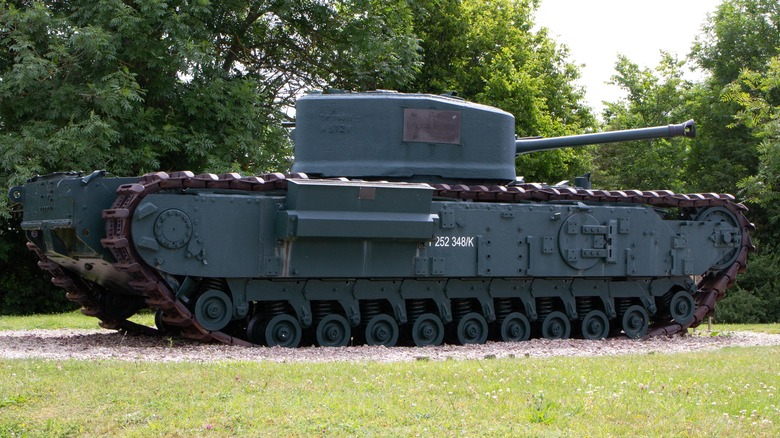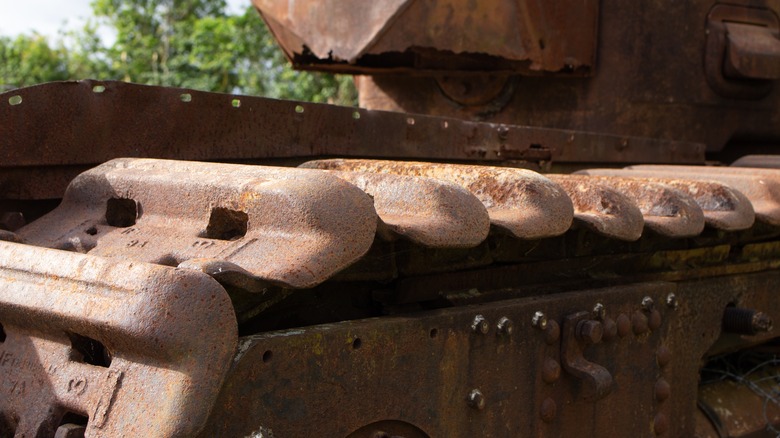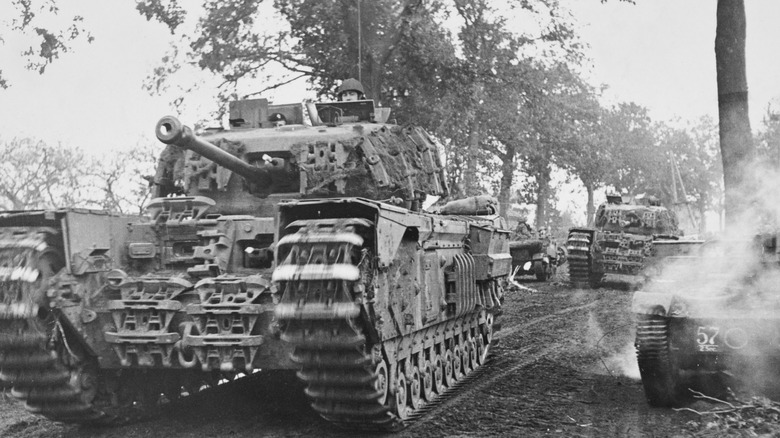Everything To Know About The Churchill Heavy Armor Tank
Winston Churchill was the living embodiment of the British mantra "Keep calm and carry on" throughout World War II. However frantic things may have been behind closed doors during the conflict, he presented a stalwart defiance in public appearances. Before the House of Commons in June 1940, he famously declared, "We shall defend our island, whatever the cost may be. We shall fight on the beaches, we shall fight on the landing grounds ... we shall never surrender."
If ever a British vehicle aimed to evoke that spirit of resilience and steely stubbornness, it would be his namesake, the Churchill tank. This venerable tank family, however, certainly had its issues. According to Calderdale Museums, the statesman once joked that it was "the tank they named after me when they found out it was no damn good!"
What was it about this model that gave it such a reputation? In this in-depth look at the Churchill tank, we'll consider its history, variations, capabilities, and how it fared in World War II.
A tank conceived for World War I part two
Approximately 9.7 million soldiers died during World War I. The world may have hoped that the horrors of such widescale conflict were behind them when it ended, but just over two decades later, World War II divided the planet once more. And with a new war came worsening weapons. But early days would show that militaries involved in the conflict expected things to be the same as World War I.
For Allied and Axis Powers commanders, rapidly arising questions included how an unfolding conflict would change the face of battle and turn the last war's technologies obsolete. In September of 1939, David Fletcher wrote in "Churchill Infantry Tank," that Britain's General Staff conceived of "a heavy tank, suitable for operating against a fixed German defensive line, crossing wide trenches, possibly over ground that had been pulverized by artillery." Combating staunch fortifications, of course, is a job for a machine designed to take a ferocious beating, and this seemed to be a philosophy that defined its creation and development.
The failings of the initial A20
The desired features for the A20, according to David Fletcher in "Churchill Infantry Tank," included "a set of recessed tracks, inside the regular ones, to assist it over very soft ground," as well as the ability to withstand the anti-tank weaponry of the time. The Churchill tank, or the A20 Char De Fortresse as it was originally known, was developed with the assumption that trench warfare from World War I would again come into play. However, it was obvious early on how different things would be between World War I and II.
The prototypes proved the A20 wasn't suited to the conflict it was designed for. In an episode of The Tank Museum's Tank Chats, Fletcher explains that, at around 40 tons and with approximately 68mm-thick armor, "which isn't even as thick as the Matilda II," the A20 was the furthest thing from a heavily armored powerhouse. The historian further notes, that just two A20s were created before the design was abandoned.
That could have been the end of the Churchill's story, but refinements on the model followed that would be marked improvements.
The weaponry of the Mark I Churchill and beyond
Vauxhall Motors Ltd. worked on the Mark I Churchill, as it's now known. This model arrived in June of 1941. This first true iteration of the Churchill was equipped with a 3-inch howitzer and 7.92mm machine guns, supporting its two-pound main gun.
Its armor was greatly thickened, reinforced to approximately 102 mm at the front. These boons are in addition to its 350 HP 12-cylinder petrol engine. The real trouble was that the formidable tanks fielded by the German military around this time had power that was difficult to compete with (some ferocious Axis tanks entered the fray). Therefore, some more advanced iterations of the Churchill were required in short order.
The weaponry of the Churchill became inadequate fast but was improved quickly with the Mark III model, which was equipped with a six-pound main gun. The weaponry continued to differ as new models arrived, with the Mark V and VIII Churchills being equipped with 95mm guns (up from the 75mm of the VI and VII Churchills). Armor upgrades would arrive alongside these, but the tank certainly wasn't without significant flaws.
The flaws of the Churchill tank family
Of the range of different weaponry these tanks were equipped with, it wasn't until the 95mm gun of the later models that they had a more solid response to different types of targets. The howitzer of the first Churchill was impractical against infantry targets (its intended use) because it could only fire in the direction the tank was facing. As this limited utility so much, it put crews in more danger than it was worth. The 95mm main gun could load the kind of rounds the old howitzer was supposed to use and anti-tank rounds, giving the weapon more versatility without cutting its movement options.
Later Churchill tanks were also more defensive. The last models boasted 152 mm thick frontal hull armor, and though the back of the hull was only 51 mm thick as with the original Churchill, it was significantly better protected elsewhere. This, however, caused further issues elsewhere.
The functional-yet-relatively-modest engine the Mark I was equipped with wasn't changed over the Churchill's lifetime. The extra armor, then, made it rather slower, and it was hardly a speedster to begin with. The Churchill's speed was around 17 mph. It was made to be a defensive behemoth, though, and despite further issues, it enjoyed considerable success on that front.
The successes and varieties of the Churchill tank
The Churchill's armor improved its longevity but decreased its speed over time. This seems like a logical progression, but there's a surprising thing about its mobility: it was almost unmatched at crossing difficult terrain. This proved to be key in combat in Africa. It could do certain things that its Axis competitors and even Allied counterparts couldn't do (the main gun for U.S. Sherman tanks, for example, struggled to break through heavy armor).
As a heavy model that retained decent mobility, it played a key role in the war. As the constant iterations on the original model proved, it was an adaptable design. Variants were kitted out for clearing areas of mines, for instance, and perhaps the most interesting variety was the Churchill Crocodile, of which 800 were manufactured from 1943. This model was equipped with a flamethrower that could reach roughly 120 meters.
The Churchill, as with many tanks of its time, was designed to meet a certain need and evolved as that same need did. Around 5,640 vehicles of the Churchill family were developed, suggesting that, for all its ups and downs, it was incredibly useful.





